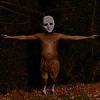Suppose there are N runners on a circle. They run with the same speed, and when two meet each other, they turn around and start running in the opposite direction. Prove that their movement is periodic.I had to think for 20 minutes before finding the answer. Can you find it too? I'll post the answer to this in 2 hours, unless someone finds it first (you can also PM me to ask for it). I hope my translation was correct enough.
Interesting mind-bender
My brother's math teacher gave him an interesting puzzle:
I had a similar problem once, only it involved ants on a meter stick stick (moving in one dimension) moving at a constant rate of 1 meter/second and determining how long it would take for them all to fall off (assuming that they can all fall off). It took me maybe five minutes. The solution there was simply to treat two ants that collide with eachother as having crossed (as when they hit eachother and change directions it is still true that there is an ant moving in each of the original directions from the same point) thus it will only take one second for all of them to fall off.
I'm not entirely sure what you mean by "periodic" though so it may be a different problem.
I'm not entirely sure what you mean by "periodic" though so it may be a different problem.
If all the runners run in the same direction, they will all cross where they started at the same time, since they're all going the same speed (or they will all return to the spot they started at in 1 period). Since they are all running the same direction they will never hit eachother.
Quote:Original post by flounder
If all the runners run in the same direction(...)
Well, that kind of defeats the purpose of the problem, doesn't it...
(I don't think that's a valid assumption to make)
Cowsarenotevil's solution (treat collisions as effectively being pass-throughs). After that observation, all runners are effectively independent and are each just running in a circle (periodic).
Quote:Original post by Nypyren
Cowsarenotevil's solution (treat collisions as effectively being pass-throughs). After that observation, all runners are effectively independent and are each just running in a circle (periodic).
So you have proven that each starting spot will be reocuppied after a given time. But is it the same runner? After all, they might start shuffling around chaotically without a period, even though they, as a whole, return to the same positions time and time again.
Well you could also say that the runners don't turn around when they collide. If they collide runner A turns around, and runner B turns around. A is now going the same direction B was and B is going the same direction A was. If A and B never turn around there will still be a runner in the same place as if they had actually turned around. (don't know how confusing that was...)
-edit- after rereading cowsarenotevil's post, I realized he beat me to it :(
-edit- after rereading cowsarenotevil's post, I realized he beat me to it :(
Quote:Original post by flounder
Well you could also say that the runners don't turn around when they collide. If they collide runner A turns around, and runner B turns around. A is now going the same direction B was and B is going the same direction A was. If A and B never turn around there will still be a runner in the same place as if they had actually turned around. (don't know how confusing that was...)
Very, very confusing... unless you mean the same thing as cowsarenotevil, at which point it's clear.
well, they don't need to travel around the whole circle. They just need to oscillate over specifice period. Therefore assuming they are at the same speed at all tmes, N people running one a circle will occupy 2[pi]r/N units of the circle, a period of 2[pi]/N, assuming they are running in opposite directions. If they all run the same direction, the period is 2[pi]. Its harder to do for a combination of the two.
You see, when I first read this, I read it as something other than it was intended. I pictured a big open field, a hundred people standing in a circle, and then everyone just picks a random direction and runs in that direction [leaving the circle], which isn't periodic at all. But if they are on a circular course, and are bound to it, then yeah it makes a lot more sense.
This topic is closed to new replies.
Advertisement
Popular Topics
Advertisement



